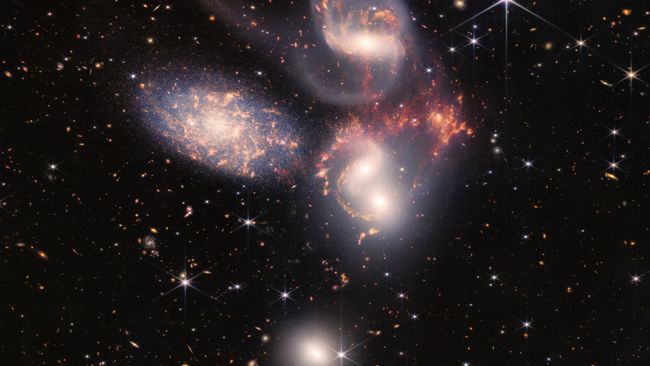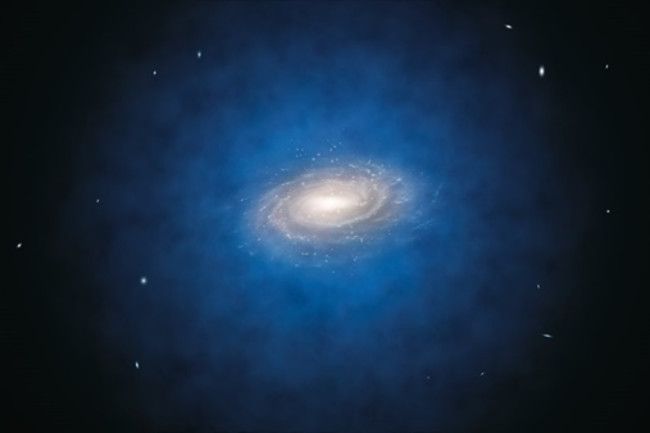The James Webb Space Telescope has the capability to focus on small, luminous galaxies in order to illuminate the mysteries of dark matter.
The identification of clusters of diminutive, luminous galaxies in the ancient cosmos would validate our alignment with the cold dark matter framework.
The University of California scientists have concluded that the James Webb Space Telescope (JWST) could potentially shed light on dark matter by studying tiny and bright galaxies in the early universe. Their simulation of the cosmos, tracking the formation of small galaxies since shortly after the Big Bang, has raised the stakes for the JWST.

Dwarf galaxies, also known as small galaxies, are spread across the universe and are believed to be some of the earliest galaxies to have formed. These galaxies have been crucial in understanding the origins and evolution of the universe.
However, astronomers have faced challenges as these galaxies do not always match their expectations. Some galaxies spin faster than anticipated, while others are less dense than simulations predict. This is where dark matter plays a role.
Scientists believe that these discrepancies could be due to the lack of consideration for the interaction between gas and dark matter in simulations. The team’s new simulation accounted for these interactions, revealing that early galaxies are smaller and brighter than previously thought. Additionally, the galaxies were observed to grow more rapidly than in other simulations.
Therefore, the UCLA team suggests that astronomers should focus on identifying small, early galaxies that are brighter than expected using the JWST and other telescopes. If these galaxies are not found, it could indicate potential flaws in our current understanding of dark matter theories.
In the dark about dark matter
Dark matter poses a significant challenge for scientists due to its lack of interaction with light, rendering it essentially invisible to observation.
The majority of the matter we are familiar with, such as stars, planets, and even ourselves, is composed of baryons that do interact with light. However, dark matter is believed to consist of non-baryonic particles, which do not interact with light.
As a result, despite comprising a substantial portion of the universe’s mass, dark matter remains undetectable through direct means, leaving scientists with a limited understanding of its composition.

Dark matter’s gravitational interaction with baryonic matter and light is crucial in understanding the structure and evolution of galaxies. The presence of dark matter was first theorized due to the inability of baryonic matter alone to account for the gravitational forces needed to hold galaxies together. Scientists believe that dark matter plays a significant role in binding galaxies and influencing their formation and growth.
In the standard cosmological model, dark matter clumps from the early universe attracted baryonic matter, leading to the formation of stars and galaxies. This model suggests that dark matter, specifically “cold dark matter,” which moves slower than the speed of light, played a key role in the slow accumulation of matter to form galaxies.
The interaction between baryonic matter and dark matter in the early universe ultimately led to the creation of galaxies as we know them today.
Claire Williams, a team member and doctoral student at UCLA, stated, “In models that do not consider streaming, this is precisely what occurs. Gas is drawn to the gravitational force of dark matter, forming dense clumps and knots where hydrogen fusion can take place, leading to the creation of stars like our sun.”
In their simulation, part of the “Supersonic Project,” Williams and her colleagues discovered that when accounting for the streaming effect between dark and ordinary matter, gas ended up far from dark matter and developing galaxies. This delayed the immediate star formation process.
After millions of years, the gas eventually returned to the galaxies, initiating a burst of star formation known as “starburst,” resulting in galaxies with a higher number of young, hot stars compared to typical small galaxies. These starburst galaxies were expected to shine brighter than others for a period.
“While streaming inhibited star formation in the smallest galaxies, it also accelerated star formation in dwarf galaxies, causing them to outshine regions of the universe without streaming,” Williams elaborated. “We anticipate that the JWST telescope will identify areas of the universe where galaxies appear brighter due to this effect.
“The increased brightness of these galaxies should make it easier for the telescope to detect these small galaxies, which are usually extremely challenging to observe only 375 million years after the Big Bang.”
The fact that dark matter is invisible implies that these small, bright galaxies in the early universe could serve as a useful indicator to test the cold dark matter theory. Failure to detect them might necessitate exploring alternative theories.
Smadar Naoz, leader of the Supersonic team and a professor of physics and astronomy at UCLA, stated that the identification of clusters of small, luminous galaxies in the ancient universe would validate the cold dark matter model. She explained that the specific type of galaxy we are seeking can only be formed by the velocity interaction between two types of matter.
Naoz emphasized that if dark matter deviates from the behavior of standard cold dark matter and the streaming effect is absent, the bright dwarf galaxies we are searching for will not be detected. In such a scenario, she highlighted the necessity of reevaluating our current understanding and theories.
The team’s research is published in The Astrophysical Journal Letters,
Do not forget to share your opinion with us to provide you with the best posts !



0 Comments